REFRIGERATOR:
A dilution refrigerator is a device that can achieve and maintain
temperatures near 7 mK.
It can be divided into four main sections: 4He pot, still,
heat exchangers and mixing chamber. A mixture of 4He
and 3He gas is condensed into the fridge at the 4He
pot, which is cooled to 1 K by evaporative cooling of 4He.
The liquid helium mixture is pumped at the still which further cools
the mixture to around 0.3 K, by evaporative cooling of 3He.
Below 0.8 K the mixture of 4He and 3He phase
separates into two phases: one is pure 3He and the other
is 4He with a small quantity of 3He, the so-called
dilute phase. The boundary between these two phases sits in the
mixing chamber. As the still is pumped, differences in vapor pressure
between the two isotopes leads to 3He being primarily
removed from the dilute phase in the still. It is then energetically
favorable for 3He in the pure side to move across the
phase boundary to replenish the dilute side. This movement of 3He
from the concentrated phase into the dilute phase is analogous to
evaporation and has associated with it a latent heat. The 3He
that is pumped off at the still is returned to the pure side of
the mixing chamber by liquification at the 4He pot and
is precooled through a series of heat exchangers in order to continue
the cooling process.
SAMPLE
REGION: CALORIMETER
Thermodynamic properties of superfluid 3He, such as specific
heat, are measured in this experimental sample region. Specific
heat measurement requires low and controlled heat capacity for materials
other than the substance of interest, 3He in this case.
Therefore, a superconducting cadmium heat switch is used to isolate
the sample cell from the nulcear stage for the measurements. Also,
low heat leak into 3He is crucial, and disconnecting
the sample cell from the nuclear stage enables us to reduce the
heat leak into 3He to as low as 80 pW. Once the sample
is cooled to sub-mK, a standard adiabatic heat pulse technique is
used to measure the heat capacity.
ADIABATIC
NUCLEAR DEMAGNETIZATION:
In the nuclear stage a paramagnetic material, either Hitachi copper
or praseodymium-nickel-5, is placed in an external magnetic field
of ~8 T. With the field in place the nuclear spins in the paramagnetic
material align parallel to the field. The field is then slowly (adiabatically)
lowered to zero and the system of nuclear spins disorder from the
low entropy (ordered) state into a configuration of higher entropy.
This proccess absorbs heat and cools the 3He down to
~500 µK.
NMR
SAMPLE REGION:
Using nuclear magnetic resonance (NMR) the spin state and spin dynamics
of superfluid phases of 3He are studied in this sample
region. This is, in fact, how the superfluid phases of 3He
were discovered and identified at Cornell University in 1972. This
discovery led to the Nobel Prize in Physics in 1996. Here at Northwestern
we have studied the magnetization of superfluid 3He-B
and NMR of superfluid 3He in aerogel.
|
|
| |
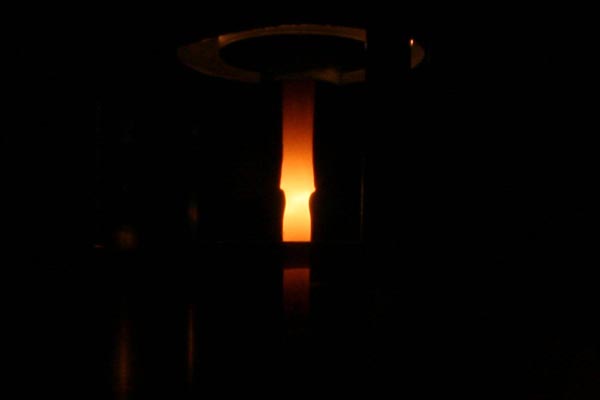
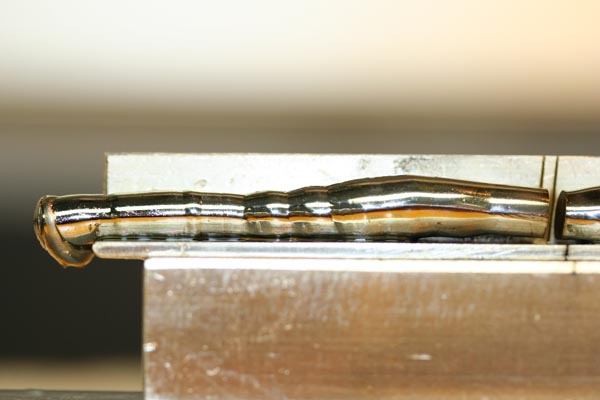
UPt3 Zone Refining and the Final Product
|
|
| |
|
|
| |
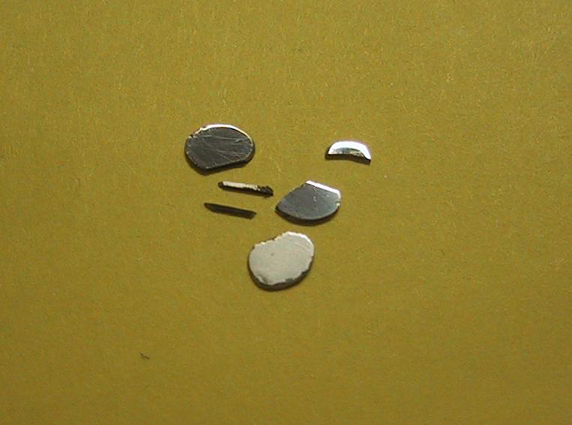 |
| UPt3 Wafers | |
The Crystal Growth and Characterization Laboratory is dedicated to producing high-quality, single crystals of the unconventional superconductor UPt3.
In addition to our own experiments, we have supplied samples to collaborators around the world for study using Josephson interference, low temperature specific heat, NMR,
high energy X-ray diffraction, magnetic penetration depth, and magnetic susceptibility among many other techniques.
| 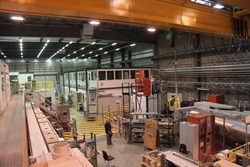 |
| Dilution Refrigerator and Sample Suspended
Above PSI Facility | |
At present, our own experimental focus is on small angle neutron scattering (SANS) from the Abrikosov vortex lattice.
Our SANS experiments, currently based at the Paul-Scherrer Institute in Villigen, Switzerland,
aim to test predictions of chirality and unusual vortex structures in the superconducting B and C phases.
The small interaction between the neutron magnetic moment and the magnetic flux quanta that form a lattice in the
superconducting mixed state provide an excellent tool for investigating the nature of the superconducting order in bulk single crystals.
The large, high quality crystals we grow at Northwestern University have shown minimal flux pinning, making them ideal for SANS experiments.
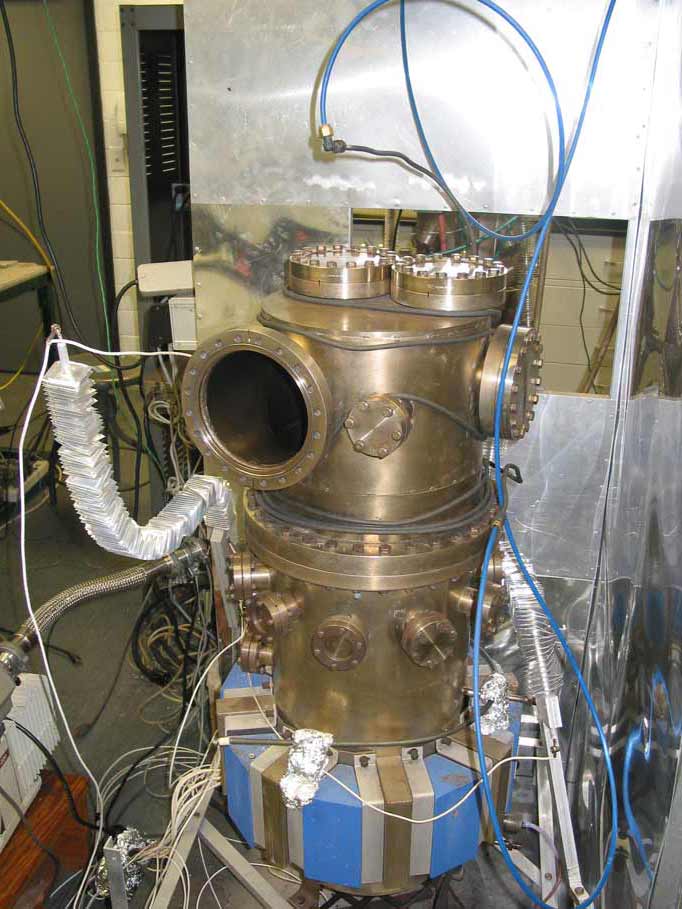 |
| Annealing Furnace |
Other experiments being considered in the near term include studying the thermal conductivity at low temperatures
in the clean limit using a unique wafer geometry, measuring the magnetoresistance in the normal state down to 7 mK
to determine the magnetic nature of the specific heat anomaly, as well as continued collaborations for neutron scattering,
Josephson tunneling, DC low-field magnetic susceptibility, and NMR.
And like all good scientists, we're continually interested in new and exciting ideas for experiments and collaborations.
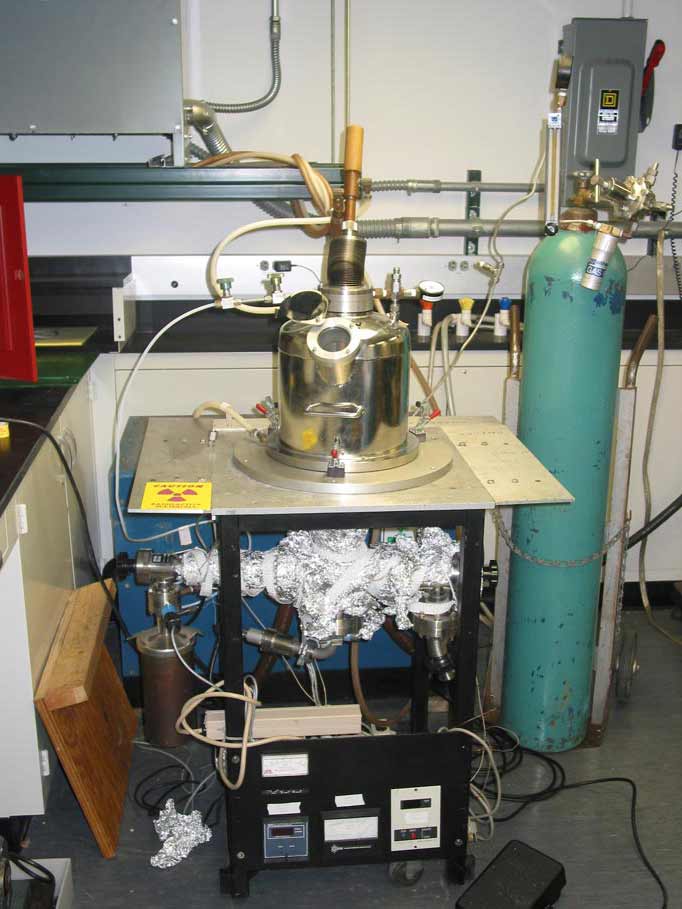 |
| Arc Melter | |
To make a crystal of UPt3, we begin by electromigration purifying uranium.
The resulting high-purity uranium is then melted with platinum at proper stoichiometry in our arc melter under a high purity argon atmosphere.
This produces polycrystalline rods, which are then loaded into the zone refiner. Under ultra high vacuum (UHV),
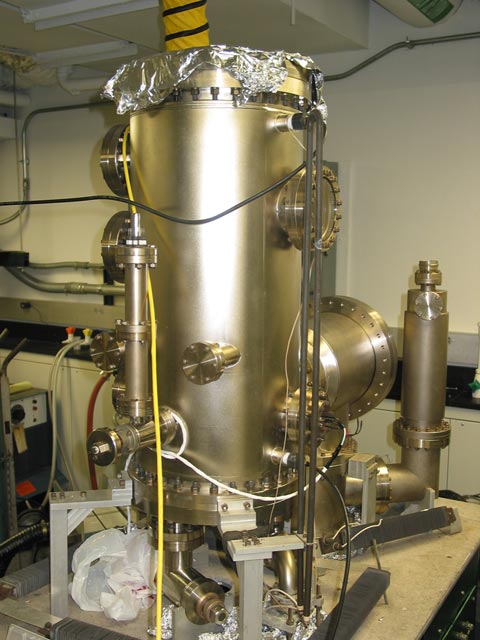 |
| Zone Refiner |
we bombard the sample with 8 kV electrons to produce a molten section in the rod, or molten zone.
This molten zone is then translated up the length of the polycrystalline material.
What is left behind after the molten zone freezes is hopefully a single crystal with randomly oriented crystallographic axes.
We then cut samples in convenient experimental geometries from the crystal by electro-discharge machining (EDM),
after identifying the symmetry axes by Laue X-ray diffraction. The samples are then etched, some are polished, and all are annealed.
Proper annealing at low temperatures in ultra high vacuum is crucial to producing the highest quality samples.
Our meticulous methodology has paid off, producing some of the finest UPt3 crystals in the world.
|
|
| |
|
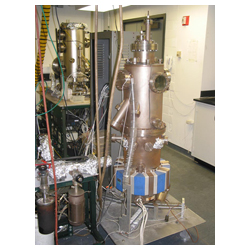
Uranium Electro-Migration
Purifier
|
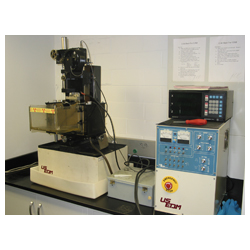
EDM
|
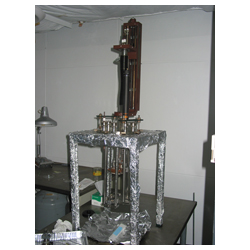
Zone Refiner Innards
|
|
| |
|
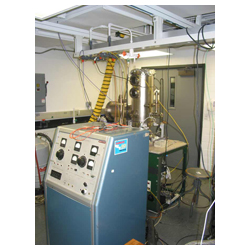
Denton High Voltage Source
(Zone Refiner in Background)
|
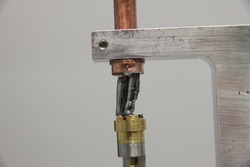
Sample Being Prepared
in Holder for Neutron Scattering
|
| |
Home
| Aerogel | 3He Calculator
| People | Facilities
| Publicati
|










